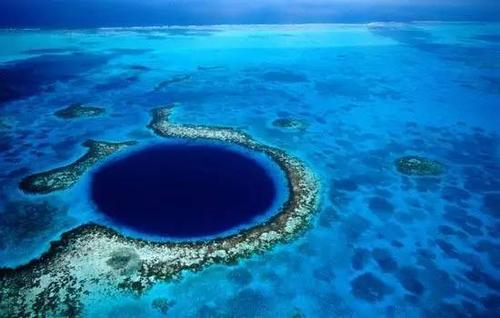Advertisement
It seems rare to see now, but in the past few years there have been many stories of downtown roads or sidewalks suddenly caving in, causing a huge risk to passing cars and pedestrians because of a drop in the water table or engineering work.
However, sinkholes are not only found on land, but also in the ocean -- mysterious “blue holes” that plunge the entrant into a dark, watery nothingness. Because in the ocean, this makes the blue hole more difficult to explore and understand.

Blue hole
Despite this, they are valuable opportunities for scientists who are eager to understand life forms and underwater conditions in unique ocean formations.
As part of an ongoing three-year research project, a multi-agency team of scientists will set out next month to explore a blue hole called the “Green Banana”, which is located on the Florida coastal continental shelf.
The project is funded by NOAA, with researchers from Mote Marine Laboratory, Florida Atlantic University, Georgia Institute of Technology, and the Geological Society of America. The green banana lies on the open surface 47 meters below the sea floor and extends to a depth of about 130 meters.
The purpose of the study was to examine the microbes living in the blue hole, measure nutrient levels in the cylindrical cave, and assess whether it was somehow connected to the groundwater system in Florida, near the Gulf of Mexico.
Advertisement
In addition to the August survey, a dive study was conducted last year in Florida -- a blue Hole known as the Amberjack Hole -- that is significantly smaller than a green banana, with a rim below 34 meters and extending down about 72 meters.
NOAA explained, “the Blue hole is filled with a diverse community of Marine life, including corals, sponges, molluscs, turtles and sharks.” The seawater in the pores is unique in chemistry and appears to interact with groundwater and possibly aquifers. This link helps to understand the carbon cycle between surface water and groundwater.”
It may take some time for us to learn more about green bananas, but samples taken from amber fish have shown large amounts of dissolved inorganic carbon in the water, which the researchers say contributes to the carbon cycle and could be the carbon source for the cave’s microbial community. Nutrient flux also showed an upward trend.
Isotopes of radium and radon were also found in the water last year, suggesting the possibility of underwater passageways linking the Florida aquifer to the Gulf of Mexico.
Advertisement
- Previous article
- Stingless Bee Honey has Special Health Benefits
- Next article
- How to Upgrade Blued in Latin America
Advertisement
OTHER NEWS

How Angelina Jolie Looks in Real Life
BY Earl

The most prominent influence on a child‘s math achievement is parents
BY Joan

Healthy Ways to Help Kids Grow Up
BY Ruby

Argentina Mourned Over Maradona’s Death for Three Days, Why a Football Player Could Own Such an Honor? (I)
BY Moore

Weight training of one arm benefits both arms
BY Gloria

Blistering Hot Weather Release SOA Pollutants from Our Very Streets
BY Andrew
RECENT NEWS
-

PUBG Mobile Esports Generated 200 Million Hours of Viewing in 2020
-

Mario Kart Tour Races to $200M revenue and 200M Downloads
-

Game Acquisitions Expand Globally in Q1 2021 with 280 Deals Worth $39 Billion Surpassing That in 2020
-

Free Fire Shows Strong Momentum, with Its Revenue Overtaking PUBG Mobile in a Single Market for Q1 2021
-

The Games Fund Launched a $50 Million Early Investment Fund to Invest in American and European Companies
-

How to Download and Install Wyze App for Free?

 1
1 1
1